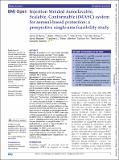| dc.contributor.author | Byrne, James D | |
| dc.contributor.author | Wentworth, Adam J | |
| dc.contributor.author | Chai, Peter R | |
| dc.contributor.author | Huang, Hen Wei | |
| dc.contributor.author | Babaee, Sahab | |
| dc.contributor.author | Li, Canchen | |
| dc.contributor.author | Becker, Sarah L | |
| dc.contributor.author | Tov, Caitlynn | |
| dc.contributor.author | Min, Seokkee | |
| dc.contributor.author | Traverso, Giovanni | |
| dc.date.accessioned | 2020-07-10T14:09:07Z | |
| dc.date.available | 2020-07-10T14:09:07Z | |
| dc.date.issued | 2020-07 | |
| dc.date.submitted | 2020-06 | |
| dc.identifier.issn | 2044-6055 | |
| dc.identifier.issn | 2044-6055 | |
| dc.identifier.uri | https://hdl.handle.net/1721.1/126121 | |
| dc.description.abstract | Objective: To develop and test a new reusable, sterilisable N95 filtering facepiece respirator (FFR)-comparable face mask, known as the Injection Molded Autoclavable, Scalable, Conformable (iMASC) system, given the dire need for personal protective equipment within healthcare settings during the COVID-19 pandemic. Design: Single-arm feasibility study. Emergency department and outpatient oncology clinic. Participants: Healthcare workers who have previously undergone N95 fit testing. Fit testing of new iMASC system. Primary and secondary outcome measures: Primary outcome is success of fit testing using an Occupational Safety and Health Administration (OSHA)-approved testing method, and secondary outcomes are user experience with fit, breathability and filter replacement. Results: Twenty-four subjects were recruited to undergo fit testing, and the average age of subjects was 41 years (range of 21–65 years) with an average body mass index of 26.5 kg/m2. The breakdown of participants by profession was 46% nurses (n=11), 21% attending physicians (n=5), 21% resident physicians (n=5) and 12% technicians (n=3). Of these participants, four did not perform the fit testing due to the inability to detect saccharin solution on premask placement sensitivity test, lack of time and inability to place mask over hair. All participants (n=20) who performed the fit test were successfully fitted for the iMASC system using an OSHA-approved testing method. User experience with the iMASC system, as evaluated using a Likert scale with a score of 1 indicating excellent and a score of 5 indicating very poor, demonstrated an average fit score of 1.75, breathability of 1.6, and ease of replacing the filter on the mask was scored on average as 2.05. Conclusions: The iMASC system was shown to successfully fit multiple different face sizes and shapes using an OSHA-approved testing method. These data support further certification testing needed for use in the healthcare setting. | en_US |
| dc.publisher | BMJ | en_US |
| dc.relation.isversionof | http://dx.doi.org/10.1136/bmjopen-2020-039120 | en_US |
| dc.rights | Creative Commons Attribution NonCommercial License 4.0 | en_US |
| dc.rights.uri | https://creativecommons.org/licenses/by-nc/4.0/ | en_US |
| dc.source | BMJ Open | en_US |
| dc.title | Injection Molded Autoclavable, Scalable, Conformable (iMASC) system for aerosol-based protection: a prospective single-arm feasibility study | en_US |
| dc.type | Article | en_US |
| dc.identifier.citation | Byrne, James D. et al. "Injection Molded Autoclavable, Scalable, Conformable (iMASC) system for aerosol-based protection: a prospective single-arm feasibility study." BMJ Open 10, 7 (July 2020): e039120 © Author(s) | en_US |
| dc.contributor.department | Massachusetts Institute of Technology. Department of Mechanical Engineering | en_US |
| dc.contributor.department | Koch Institute for Integrative Cancer Research at MIT | en_US |
| dc.relation.journal | BMJ Open | en_US |
| dc.eprint.version | Final published version | en_US |
| dc.type.uri | http://purl.org/eprint/type/JournalArticle | en_US |
| eprint.status | http://purl.org/eprint/status/PeerReviewed | en_US |
| dspace.date.submission | 2020-07-10T11:40:54Z | |
| mit.journal.volume | 10 | en_US |
| mit.journal.issue | 7 | en_US |
| mit.license | PUBLISHER_CC | |
| mit.metadata.status | Complete | |
